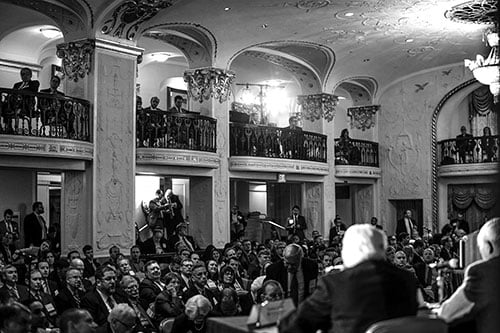Facts of the Case
Amid intense public interest, Congress passed the Patient Protection and Affordable Care Act (ACA), which became effective March 23, 2010. The ACA sought to address the fact that millions of Americans had no health insurance, yet actively participated in the health care market, consuming health care services for which they did not pay.
The ACA contained a minimum coverage provision by amending the tax code and providing an individual mandate, stipulating that by 2014, non-exempt individuals who failed to purchase and maintain a minimum level of health insurance must pay a tax penalty. The ACA also contained an expansion of Medicaid, which states had to accept in order to receive Federal funds for Medicaid, and an employer mandate to obtain health coverage for employees.
Shortly after Congress passed the ACA, Florida and 12 other states brought actions in the United States District Court for the Northern District of Florida seeking a declaration that the ACA was unconstitutional on several grounds. These states were subsequently joined by 13 additional states, the National Federation of Independent businesses, and individual plaintiffs Kaj Ahburg and Mary Brown.
The plaintiffs argued that: (1) the individual mandate exceeded Congress' enumerated powers under the Commerce Clause; (2) the Medicaid expansions were unconstitutionally coercive; and (3) the employer mandate impermissibly interfered with state sovereignty.
The District Court first addressed whether the plaintiffs had standing to bring the lawsuit. It determined that Brown had standing to challenge the minimum coverage provision because she did not have health insurance and had to make financial arrangements to ensure compliance with the provision, which would go into effect in 2014. The court further determined that Idaho and Utah had standing because each state had enacted a statute purporting to exempt their residents from the minimum coverage provision.
The court also concluded that the Anti-Injunction Act did not bar the suit.
The District Court then addressed the constitutional questions. It ruled that the individual mandate provision was not a valid exercise of Congress' commerce or taxing powers. The court held the entire act invalid because the mandate could not be severed from any other provision. The court dismissed the states' challenge to the employer mandates and granted judgment to the federal government on the Medicaid expansions, finding insufficient support for the contention that the spending legislation was unconstitutionally coercive.
A panel of the U.S. Court of Appeals for the Eleventh Circuit affirmed 2-to-1 the District Court's holdings as to the Medicaid expansions and the individual mandate. But it also reversed the District Court, holding that the individual mandate could be severed without invalidating the remainder of the ACA.
Questions
Is the suit brought by respondents to challenge the minimum coverage provision of the Patient Protection and Affordable Care Act barred by the Anti-Injunction Act, 2 U.S.C. 7421(a)?
Does Congress have power under Article I, Section 8 of the Constitution, specifically under the Commerce Clause or the Taxing and Spending Clause, to require most Americans to purchase health insurance?
Is the individual mandate severable from the ACA?
Conclusions
-
The justices unanimously agreed that the Anti-Injunction Act did not bar the suit. Congress did not intend that the payment for non-compliance with the Individual Mandate be a tax for purposes of the Anti-Injunction Act.
-
Chief Justice Roberts, joined by Justices Ginsburg, Breyer, Sotomayor, and Kagan, concluded that the Individual Mandate penalty is a tax for the purposes of the Constitution's Taxing and Spending Clause and is a valid exercise of Congressional authority. The payment is not so severe as to be coercive, is not limited to willful violations like fines for unlawful acts, and is collected by the Internal Revenue Service by normal means.
As part of a jointly written dissenting opinion, Justices Antonin Scalia, Anthony Kennedy, Clarence Thomas, and Samuel Alito disagreed, arguing that because Congress characterized the payment as a penalty, to instead characterize it as a tax would amount to rewriting the Act.
-
Chief Justice Roberts, with Justices Scalia, Kennedy, Thomas, and Alito, concluded that the Individual Mandate was not a valid exercise of Congress' power to regulate commerce. The Commerce Clause allows Congress to regulate existing commercial activity, but not to compel individuals to participate in commerce. This would open a new realm of Congressional authority.
Justice Ginsburg, as part of an opinion concurring in part and dissenting in part, joined by Justices Breyer, Sotomayor, and Kagan disagreed with this conclusion, arguing that the Chief Justice's distinction between economic "activity" and "Inactivity" is ill-defined and unsupported by either the Court's precedents or the text of the Constitution. Furthermore, even if the distinction were permissible, individuals who fail to purchase insurance nonetheless frequently participate in the healthcare marketplace, substantially impacting healthcare commerce, and may therefore be regulated by Congress.
Justice Thomas, in a separate dissent, added that the "substantial effects test" has encouraged Congress to push the limits of its power.
Health Care Decision: NFIB v. Sebelius - Podcast
Federalism & Separation of Powers Practice Group Podcast
To listen, please right click on the audio file you wish to hear and then...
Can the South Carolina Legislature Pass a Law to “Nullify” Obamacare?
Federalist Society White Paper
Can a State enact a law that purports to “nullify” a controversial federal statute that...
Size Doesn't Matter: Why Shrinking the Supreme Court Won't Promote Constitutionally Limited Government
The Supreme Court needs to be cut down to size. So argues Professor Michael Stokes...
Should the “Hollow Core” of Constitutional Theory Be Filled with the Framers’ Intentions?
Federalist Society Review, Volume 22
A Review of The Hollow Core of Constitutional Theory: Why We Need the Framers, by...
The Mythical McCulloch
Federalist Society Review, Volume 21
A Review of The Spirit of the Constitution: John Marshall and the 200-Year Odyssey of...
Originalism as King
Federalist Society Review, Volume 22
A review of The President Who Would Not Be King: Executive Power under the Constitution,...
Ohio Challenges Constitutionality of “Tax Mandate” in Biden Stimulus
On March 11, 2021, President Biden signed into law the American Rescue Plan Act (ARPA),...
The CDC’s Eviction Moratorium Is Unconstitutional
Note: This blog was originally posted at the Cato Institute's Cato at Liberty blog. ...
Voting News: The 11th Circuit Holds That Postage to Mail Ballots Is Not an Unconstitutional Poll Tax
In the State of Georgia, voters must pay for postage when submitting mail-in and absentee...
Countdown to the National Lawyers Convention: What's "Conservative" about the "Roberts" Court?
Next week, I will participate in the Federalist Society’s National Lawyers Convention, in Washington, D.C.,...
An Imagined Bloc and Other Figments
Federalist Society Review, Volume 21
A review of American Justice 2019: The Roberts Court Arrives, by Mark Joseph Stern (University...
Does EPA’s Clean Power Plan Proposal Violate the States’ Sovereign Rights?
Engage Volume 16, Issue 1
Note from the Editor: This article discusses the Environmental Protection Agency’s Clean Power Plan under...
The Meaning of "Regulate Commerce" to the Constitution's Ratifiers
Federalist Society Review, Volume 23
I. Previous Scholarship[1] A. Views of “Commerce”: Traditional and “Mega” The Constitution grants Congress power...
A Federal Gestational Age Abortion Ban is the Wrong (and Unconstitutional) Hill for the Pro-Life Movement to Die On
In Dobbs v. Jackson Women’s Health Organization, decided in June 2022, the Supreme Court overruled...
The False Doctrine of Inherent Sovereign Authority
Federalist Society Review, Volume 24
This essay examines the hypothesis that the federal government and its departments and officials hold...
Courthouse Steps Oral Arguments Teleforum: California v. Texas
Federalism and Separation of Powers Teleforum
TeleforumAmicus Advocacy: Fighting for Small Businesses at the U.S. Supreme Court
Maggianos Little Italy Denver Pavilions 500 16th St #150 (On the 16th Street Mall)Denver, 80202
Terms of Engagement: How Our Courts Should Enforce the Constitution's Promise of Limited Government
McCormick & Schmick's 4th & Hope StreetsLos Angeles, 90071






















